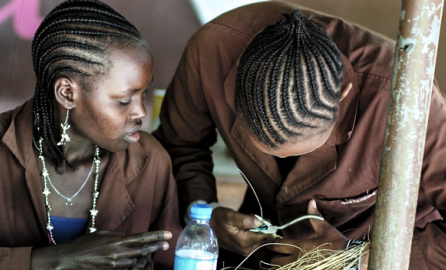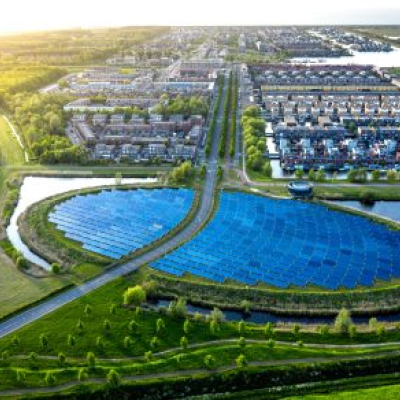With a population predicted to grow to 9.6 billion by 2050, according to the UN, and increasing resource scarcity to match – shifting to a sustainable economic model is quickly becoming an imperative. A majority of this growth is expected to occur in developing and middle-income countries – those with the highest vulnerability to climate change and with the least resources to marshal against it.
Capacity4dev caught up with the European Commission and Chatham House, a think tank based in London, to find out what a circular economy means for the developing world – and how it can be promoted in development cooperation.
Why does circularity need to happen? “The need to shift away from a linear production model becomes particularly clear if you look at the projection for population growth and urbanisation,” said Astrid Schomaker, Director of Global Sustainable Environment at the Directorate General for Environment (DG ENV).
With urban zones expected to house close to 66% of the world’s population by 2050, according to the UN – Schomaker explained that managing the process will present many challenges.
“The construction of a city is enormously resource intensive,” she said. “If we continue by building cities the way we do, not taking care of the recyclability of construction materials or the liveability of the cities, you set yourself up for a crisis that we would like to avoid.”
|
What exactly is circular economy? The term implies a systematic and fundamental shift away from linear growth. Whereas resources are extracted, refined into objects for sale, and discarded for use in classical growth models, a circular approach looks to close the loop. Recycling waste into new inputs is just one component of this. Circular economy touches on everything from object design (making it easier to repair and upgrade items) to rethinking how goods are provided to consumers. |
Circular economy is not just about cities – from consumption patterns to global supply chains, the environmental impact of a business-as-usual approach risks being dire. “I don’t want to speculate about doomsday scenarios, but getting it wrong is simply not an option,” said Schomaker.
Benefits to be reaped
Since the introduction of the European Commission’s 2015 Circular Economy Package, circular economy has been catching on fast. “I don’t think we have ever seen a new political concept gain so much traction in such a short time,” said Schomaker.
Ensuring wider buy in, however, will require pragmatism. “We need to demonstrate what works – not discuss what happens if you don’t do it, but really look at the concrete economic growth benefits,” she said. “We will have to succeed, but we can’t do it on our own.”
The benefits are clear for governments – but they aren’t the only ones to gain. According to Schomaker, private sector engagement with circular economy could reduce risks posed by price volatility, dependency on foreign imports, and lead to savings on raw material costs. As the century goes on and resources become scarcer, these are likely to become all the more important.
“We essentially see the circular economy as a triple win model” explained Schomaker. In addition to stemming environmental risks, circular economy would increase economic stability, along with providing for important social benefits – such as job creation. Empowering consumers, mandating eco-design and better product information, and promoting an understanding of the concept among populations are some ways she listed to speed things up.
Implications for development
“I think it’s important we avoid this becoming a discussion where developing countries feel left behind” said Schomaker, addressing the impact circular economy would have on international trade.
“The important thing is that the countries that mostly rely on primary resource production understand how they can become part of a different, more sustainable, model,” she said, adding that the transition would not happen overnight.
Schomaker sees the concept gaining a lot of traction in both developed and developing countries. “You have countries like Rwanda banning plastic bags, South Africa overhauling its waste system, and India setting up a research panel on the benefits of circularity.”
|
Watch Schomaker explain how the European Commission is working on circular economy matters here: |
DG ENV organises circular economy missions, in partnership with business leaders, to promote the benefits it can bring developing countries. Schomaker explained that DG ENV would like to work more closely with these countries in developing resource efficiency strategy and engaging in political dialogue, though Commission involvement with partner countries is also being done through the Directorate General for Development and Cooperation (DEVCO).
Schomaker said more research is needed on circular economy in partner countries alongside research on its implications for Europe. “We need to understand where they come from, where the challenges are, but also where the opportunities that we can promote are. We need to be aware of the trade-offs and have an honest discussion.”
From the research being done
Among the first studies conducted to this end is Chatham House’s recent publication A Wider Circle? The Circular Economy in Developing Countries, which details the potential gains from the approach. The publication makes the case that in many ways, developing countries are well positioned for the transition due to an existing higher degree of circularity compared to developed countries.
“What’s exciting about circular economy models is that they tackle a number of problems at once,” said Felix Preston, co-author of the publication. With a circular economy strategy providing a way to ‘leapfrog’ from unsustainable development pathways – in turn addressing rising pollution rates and providing for clean jobs – the publication is carefully optimistic about the possibilities if the window of opportunity is taken.
Despite the substantial focus on the environmental and health benefits, most governments’ interest in circular economy have been focused on the bottom line. “What we’re hearing from ministries of industry and senior offices, is that they want to understand how it’s connected to the ambitions they have for their population to move up the development ladder and create more jobs,” Preston said.
A recycling plant in Rwanda © Rwanda Green Fund/Flickr
“The examples are certainly there – in Kenya, there is a company dealing with e-waste management that in just four years has generated over two thousand jobs.” With the research’s findings that circular economy could boost low-skill jobs in processing waste while allowing for the development of a skilled workforce in remanufacturing.
Preston further explained that circular economy models offer attractive opportunities to counter the erosion of traditional industrialisation opportunities by automation and technological advances. However, he stressed that interventions need to be analysed individually to ensure they are consistent with environmental commitments – as this is not guaranteed in all cases.
Harmonising European and development interests
As one of the largest consuming blocks in the world, the EU will have a lot of power in directing development through its policies. The private sector – with headquarters in Europe and supply chains extending through the developing world – will also play a key role. “I think we’re likely to see these companies really taking a lead in shaping the agenda and working with developing countries to make the circular economy a win-win proposition,” Preston said.
Gains aside, Preston believes that we will start to see political tensions arising through policies which inadvertently affect national economies. While countries with economies focused on the export of raw materials would likely have time to adjust, “the more immediate concern is that countries which currently receive waste from the EU, for example e-waste… may suddenly be faced with a cliff edge problem if European rules are changed.”
|
Watch Preston discuss the circular economy and emerging economies here: |
“At a national level, there are political dynamics too, of course,” said Preston – in both the developing and the developed world. “Existing sectors which benefit from the status quo may not be encouraging with respect to a more ambitious circular economy strategy,” he said – which creates an important challenge to be managed internationally.
“What we are calling for is a greater dialogue in the European Union and to make sure that dialogues are established with developing countries to manage any potential problems, invest in support required for the transition, and more importantly, capitalise on the local benefits that could be generated by employing the circular economy within national development strategies.”
A mandate to fight for
For Thibaut Portevin, Policy Officer on the Green Economy at DG DEVCO, circular economy provides a way of contributing to the achievement of the Sustainable Development Goals, in particular the target on decoupling growth from environmental degradation. Furthermore, the New European Consensus on Development refers to this explicitly, he explained – providing a clear mandate to work from.
Getting all actors on board to ensure coherent circular economy policies represents another challenge. “Environmentally sustainable policies are often promoted by ministries of environment, which in many countries are some of the weakest ministries,” Thibaut said. “On the other hand you have economic policies which often ignore environmental sustainable issues.”
“Circular economy is not just a concept, but something that works on the ground – and not just in Europe”
“We have a lot of opportunities to promote the circular economy through our programmes and policy dialogues,” said Portevin. The new External Investment Plan and its thematic windows, such as micro, small, and medium enterprises (MSMEs) financing and sustainable cities, offer useful entry points. “These are areas where practices like improved waste management, recycling, and sustainable consumption and productions practices can be promoted,” Portevin said.
One example Portevin provided is the EU’s SWITCH to Green flagship initiative, which supports small businesses in adopting sustainable consumption and production practices. According to Portevin, the results have been encouraging, with companies saving on costs, improving their image and reputation, and even widening their market access as a result of the adoption of greener practices.
“We do see a lot of benefits from these processes and we’re trying to encourage them at a larger scale,” Portevin said, noting that limited access to finance for green MSME’s remains a barrier to wider uptake.
|
Watch Thibaut discuss the work of DEVCO on the circular economy here: |
Another example is the Partnership for Action on Green Economy (PAGE), which supports partner countries in developing enabling frameworks. One of the requirements for countries willing to join is that they demonstrate commitment from several different ministries, ensuring that engagement is not fragmented at a national level.
“Circular economy is more than a concept, it's something that works on the ground – and not just in Europe,” Portevin said. “I think the science is very clear on the environmental crisis we are facing. The question is not what happens if we get things wrong, but whether we respond at the right pace and on the necessary scale.”
Image credit: Roman Boed/Flickr via Creative Commons license 2.0
This article was written by Craig Hill, Journalist and Content Editor at Capacity4dev, with input from DG ENV, DG DEVCO and Chatham House.





Log in with your EU Login account to post or comment on the platform.